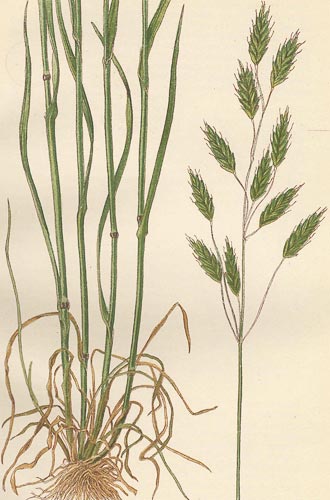Weeds
Bromus secalinus L. - Rye brome.
Taxonomy:
Family Poaceae Bernhart (Graminea), Genus Bromus L.Biology type:
Spring annual.Morphology and biology:
Stems are 60-120 cm in height, glabrous, rough in nodes. Laminae are tomentose, 2-5 mm in width. Leaf-sheaths are usually hairless or in lower leaves they have very short hairs. Ligula is 1-2 mm in length. Panicles are up to 21 cm in length. Spikelets are 11-20 mm in length, consisting of 6-8 flowers. Lemmata are 6-8 mm in length, widely divergent when mature, with involuted edges and awnes up to 7 mm in length or without awnes. Awnes at fruit are bent back; flowers in May-June, produces fruits in July-August. Seeds begin germinating from a depth of 1-5 cm in autumn. One plant produces up to 5000-6000 caryopsides. After ripening seeds shed and are difficult to separate from crop. This weed is not found as a wild-growing plant; life-cycle fully coincides with that of the crop.Geographical range:
This is mainly a European species; distributed all over Western Europe (except far south). This weed was brought to North America. It also occurs in the Caucasus, Mediterranean, and Asia Minor. In Russia it is distributed in many regions of the European part except Arctic. As an adventitious plant it occurs in the south of Siberia and Far East. This weed is found in all regions of Middle Russia, more often in the north-western parts. The eastern limit of rye brome area lies in Russia.Ecology:
The occurrence of rye brome in the northwestern regions is connected with its preference of heavy, clay, over-wet and cold soils which are in this area. It is rarely found on sandy-loam and loamy soils, mainly in field margins of winter crops.Economic importance:
This is an important weed in winter rye. It is also found in winter wheat. Rye brome has non-shattering seeds and is harvested at the same time as the winter crop, so seed infests grain. Control measures: thorough cleaning of crop seeds to remove weed seeds, land improvement of over-wet soils, raising of soil capacity, sowing of winter rye after fallow or perennial grasses.Reference citations:
Gubanov I.A., Kiseleva K.V., Nopvikov V.S., Tichomirov V.N. 2002. Illustrated identification book on plants of Middle Russia. Moscow. V.1: 526.Nikitin V.V. 1983. Weeds in the flora of the USSR. Leningrad: Nauka. 454 pp.
Volkov A.N., ed. 1935. The regions of the distribution of the main weeds in the USSR. Moscow-Leningrad: Publishing House of Kolchoz & Sovchoz Literature. 153 pp.


